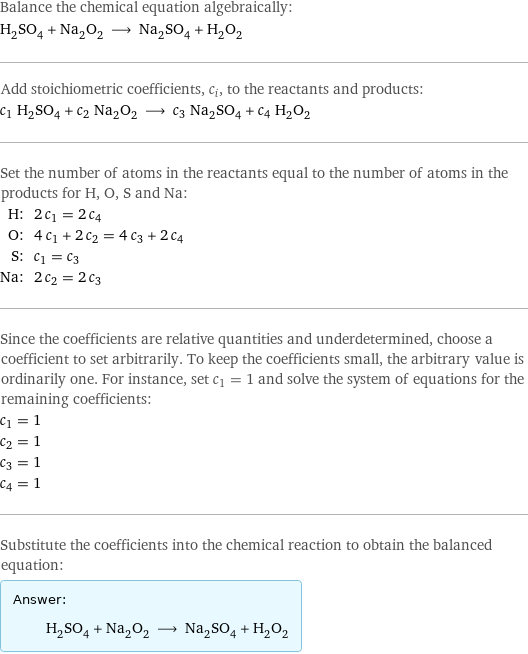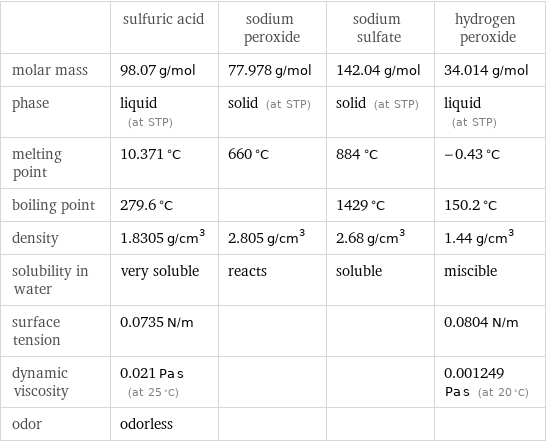Input interpretation

H_2SO_4 sulfuric acid + Na_2O_2 sodium peroxide ⟶ Na_2SO_4 sodium sulfate + H_2O_2 hydrogen peroxide
Balanced equation

Balance the chemical equation algebraically: H_2SO_4 + Na_2O_2 ⟶ Na_2SO_4 + H_2O_2 Add stoichiometric coefficients, c_i, to the reactants and products: c_1 H_2SO_4 + c_2 Na_2O_2 ⟶ c_3 Na_2SO_4 + c_4 H_2O_2 Set the number of atoms in the reactants equal to the number of atoms in the products for H, O, S and Na: H: | 2 c_1 = 2 c_4 O: | 4 c_1 + 2 c_2 = 4 c_3 + 2 c_4 S: | c_1 = c_3 Na: | 2 c_2 = 2 c_3 Since the coefficients are relative quantities and underdetermined, choose a coefficient to set arbitrarily. To keep the coefficients small, the arbitrary value is ordinarily one. For instance, set c_1 = 1 and solve the system of equations for the remaining coefficients: c_1 = 1 c_2 = 1 c_3 = 1 c_4 = 1 Substitute the coefficients into the chemical reaction to obtain the balanced equation: Answer: | | H_2SO_4 + Na_2O_2 ⟶ Na_2SO_4 + H_2O_2
Structures

+ ⟶ +
Names

sulfuric acid + sodium peroxide ⟶ sodium sulfate + hydrogen peroxide
Reaction thermodynamics
Gibbs free energy

| sulfuric acid | sodium peroxide | sodium sulfate | hydrogen peroxide molecular free energy | -690 kJ/mol | -447.7 kJ/mol | -1270 kJ/mol | -120.4 kJ/mol total free energy | -690 kJ/mol | -447.7 kJ/mol | -1270 kJ/mol | -120.4 kJ/mol | G_initial = -1138 kJ/mol | | G_final = -1391 kJ/mol | ΔG_rxn^0 | -1391 kJ/mol - -1138 kJ/mol = -252.9 kJ/mol (exergonic) | | |
Equilibrium constant
![Construct the equilibrium constant, K, expression for: H_2SO_4 + Na_2O_2 ⟶ Na_2SO_4 + H_2O_2 Plan: • Balance the chemical equation. • Determine the stoichiometric numbers. • Assemble the activity expression for each chemical species. • Use the activity expressions to build the equilibrium constant expression. Write the balanced chemical equation: H_2SO_4 + Na_2O_2 ⟶ Na_2SO_4 + H_2O_2 Assign stoichiometric numbers, ν_i, using the stoichiometric coefficients, c_i, from the balanced chemical equation in the following manner: ν_i = -c_i for reactants and ν_i = c_i for products: chemical species | c_i | ν_i H_2SO_4 | 1 | -1 Na_2O_2 | 1 | -1 Na_2SO_4 | 1 | 1 H_2O_2 | 1 | 1 Assemble the activity expressions accounting for the state of matter and ν_i: chemical species | c_i | ν_i | activity expression H_2SO_4 | 1 | -1 | ([H2SO4])^(-1) Na_2O_2 | 1 | -1 | ([Na2O2])^(-1) Na_2SO_4 | 1 | 1 | [Na2SO4] H_2O_2 | 1 | 1 | [H2O2] The equilibrium constant symbol in the concentration basis is: K_c Mulitply the activity expressions to arrive at the K_c expression: Answer: | | K_c = ([H2SO4])^(-1) ([Na2O2])^(-1) [Na2SO4] [H2O2] = ([Na2SO4] [H2O2])/([H2SO4] [Na2O2])](../image_source/4293f1af521cc2a16aa784b95adf3db3.png)
Construct the equilibrium constant, K, expression for: H_2SO_4 + Na_2O_2 ⟶ Na_2SO_4 + H_2O_2 Plan: • Balance the chemical equation. • Determine the stoichiometric numbers. • Assemble the activity expression for each chemical species. • Use the activity expressions to build the equilibrium constant expression. Write the balanced chemical equation: H_2SO_4 + Na_2O_2 ⟶ Na_2SO_4 + H_2O_2 Assign stoichiometric numbers, ν_i, using the stoichiometric coefficients, c_i, from the balanced chemical equation in the following manner: ν_i = -c_i for reactants and ν_i = c_i for products: chemical species | c_i | ν_i H_2SO_4 | 1 | -1 Na_2O_2 | 1 | -1 Na_2SO_4 | 1 | 1 H_2O_2 | 1 | 1 Assemble the activity expressions accounting for the state of matter and ν_i: chemical species | c_i | ν_i | activity expression H_2SO_4 | 1 | -1 | ([H2SO4])^(-1) Na_2O_2 | 1 | -1 | ([Na2O2])^(-1) Na_2SO_4 | 1 | 1 | [Na2SO4] H_2O_2 | 1 | 1 | [H2O2] The equilibrium constant symbol in the concentration basis is: K_c Mulitply the activity expressions to arrive at the K_c expression: Answer: | | K_c = ([H2SO4])^(-1) ([Na2O2])^(-1) [Na2SO4] [H2O2] = ([Na2SO4] [H2O2])/([H2SO4] [Na2O2])
Rate of reaction
![Construct the rate of reaction expression for: H_2SO_4 + Na_2O_2 ⟶ Na_2SO_4 + H_2O_2 Plan: • Balance the chemical equation. • Determine the stoichiometric numbers. • Assemble the rate term for each chemical species. • Write the rate of reaction expression. Write the balanced chemical equation: H_2SO_4 + Na_2O_2 ⟶ Na_2SO_4 + H_2O_2 Assign stoichiometric numbers, ν_i, using the stoichiometric coefficients, c_i, from the balanced chemical equation in the following manner: ν_i = -c_i for reactants and ν_i = c_i for products: chemical species | c_i | ν_i H_2SO_4 | 1 | -1 Na_2O_2 | 1 | -1 Na_2SO_4 | 1 | 1 H_2O_2 | 1 | 1 The rate term for each chemical species, B_i, is 1/ν_i(Δ[B_i])/(Δt) where [B_i] is the amount concentration and t is time: chemical species | c_i | ν_i | rate term H_2SO_4 | 1 | -1 | -(Δ[H2SO4])/(Δt) Na_2O_2 | 1 | -1 | -(Δ[Na2O2])/(Δt) Na_2SO_4 | 1 | 1 | (Δ[Na2SO4])/(Δt) H_2O_2 | 1 | 1 | (Δ[H2O2])/(Δt) (for infinitesimal rate of change, replace Δ with d) Set the rate terms equal to each other to arrive at the rate expression: Answer: | | rate = -(Δ[H2SO4])/(Δt) = -(Δ[Na2O2])/(Δt) = (Δ[Na2SO4])/(Δt) = (Δ[H2O2])/(Δt) (assuming constant volume and no accumulation of intermediates or side products)](../image_source/b253531ff5d5b40cb7f2c3bc713633d5.png)
Construct the rate of reaction expression for: H_2SO_4 + Na_2O_2 ⟶ Na_2SO_4 + H_2O_2 Plan: • Balance the chemical equation. • Determine the stoichiometric numbers. • Assemble the rate term for each chemical species. • Write the rate of reaction expression. Write the balanced chemical equation: H_2SO_4 + Na_2O_2 ⟶ Na_2SO_4 + H_2O_2 Assign stoichiometric numbers, ν_i, using the stoichiometric coefficients, c_i, from the balanced chemical equation in the following manner: ν_i = -c_i for reactants and ν_i = c_i for products: chemical species | c_i | ν_i H_2SO_4 | 1 | -1 Na_2O_2 | 1 | -1 Na_2SO_4 | 1 | 1 H_2O_2 | 1 | 1 The rate term for each chemical species, B_i, is 1/ν_i(Δ[B_i])/(Δt) where [B_i] is the amount concentration and t is time: chemical species | c_i | ν_i | rate term H_2SO_4 | 1 | -1 | -(Δ[H2SO4])/(Δt) Na_2O_2 | 1 | -1 | -(Δ[Na2O2])/(Δt) Na_2SO_4 | 1 | 1 | (Δ[Na2SO4])/(Δt) H_2O_2 | 1 | 1 | (Δ[H2O2])/(Δt) (for infinitesimal rate of change, replace Δ with d) Set the rate terms equal to each other to arrive at the rate expression: Answer: | | rate = -(Δ[H2SO4])/(Δt) = -(Δ[Na2O2])/(Δt) = (Δ[Na2SO4])/(Δt) = (Δ[H2O2])/(Δt) (assuming constant volume and no accumulation of intermediates or side products)
Chemical names and formulas

| sulfuric acid | sodium peroxide | sodium sulfate | hydrogen peroxide formula | H_2SO_4 | Na_2O_2 | Na_2SO_4 | H_2O_2 Hill formula | H_2O_4S | Na_2O_2 | Na_2O_4S | H_2O_2 name | sulfuric acid | sodium peroxide | sodium sulfate | hydrogen peroxide IUPAC name | sulfuric acid | disodium peroxide | disodium sulfate | hydrogen peroxide
Substance properties

| sulfuric acid | sodium peroxide | sodium sulfate | hydrogen peroxide molar mass | 98.07 g/mol | 77.978 g/mol | 142.04 g/mol | 34.014 g/mol phase | liquid (at STP) | solid (at STP) | solid (at STP) | liquid (at STP) melting point | 10.371 °C | 660 °C | 884 °C | -0.43 °C boiling point | 279.6 °C | | 1429 °C | 150.2 °C density | 1.8305 g/cm^3 | 2.805 g/cm^3 | 2.68 g/cm^3 | 1.44 g/cm^3 solubility in water | very soluble | reacts | soluble | miscible surface tension | 0.0735 N/m | | | 0.0804 N/m dynamic viscosity | 0.021 Pa s (at 25 °C) | | | 0.001249 Pa s (at 20 °C) odor | odorless | | |
Units
